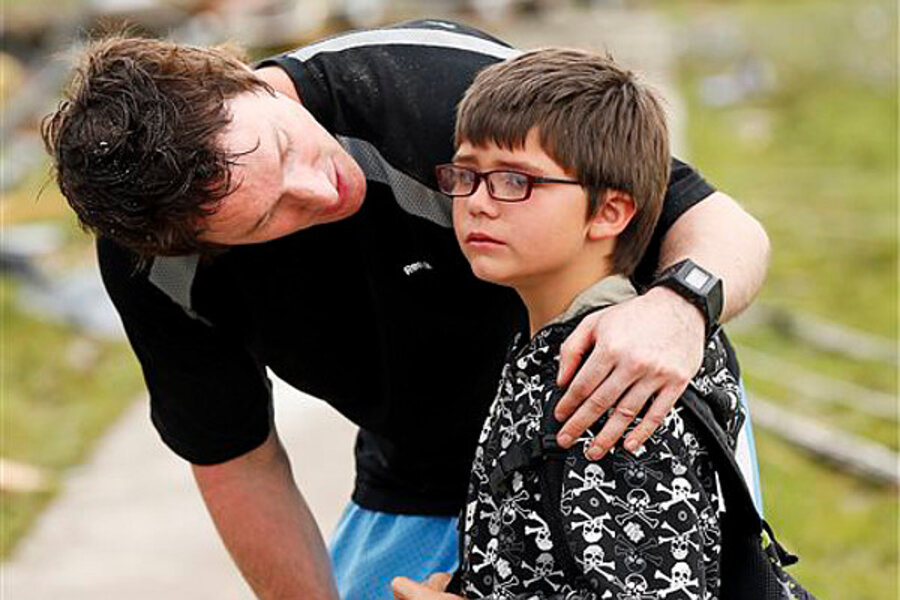Oklahoma tornado heroes: Teachers saved kids' lives
Loading...
| MOORE, Oklahoma
The principal's voice came on over the intercom at Plaza Towers Elementary School: A severe storm was approaching and students were to go to the cafeteria and wait for their parents to pick them up.
But before all of the youngsters could get there, the tornado alarm sounded.
The plan changed quickly.
"All the teachers started screaming into the room and saying, 'Get into the hallway! We don't want you to die!' and stuff like that," said sixth-grader Phaedra Dunn. "We just took off running."
In the moments that followed, some of the children at Plaza Towers Elementary would, in fact, die. At least seven were killed by the twister Monday afternoon. Others would crawl out of the rubble, wounded and scared.
The tornado that devastated this Oklahoma City suburb of 56,000 people destroyed Plaza Towers and also slammed Briarwood Elementary, where all the children appear to have survived. Students and parents recounted stories Tuesday of brave teachers who sheltered their pupils, in some cases by herding them into a closet and a restroom amid the fear and panic.
After the tornado alarm went off, students at Plaza Towers scrambled into the halls. But the halls — some of which were within the view of windows — did not appear safe enough.
Sixth-grader Antonio Clark said a teacher took him and as many other youngsters as possible and shoved them into the three-stall boys' bathroom.
"We were all piled in on each other," the 12-year-old said. Another teacher wrapped her arms around two students and held Antonio's hand.
Twenty seconds later he heard a roar that sounded like a stampede of elephants. His ears popped.
Then it all stopped almost as suddenly as it started. Crouched down, his backpack over his head, Antonio looked up. The skylight and the ceiling were gone, and he was staring up into a cloud filled with debris.
Antonio and a friend were among the first to stand up. They climbed over debris where their classroom had been just moments earlier. Students and teachers were struggling to free themselves from under the bricks, wooden beams and insulation. Some people had bleeding head wounds; blood covered one side of someone's eyeglasses, Antonio said.
"Everybody was crying," Antonio said. "I was crying because I didn't know if my family was OK."
Then Antonio saw his father ride up on a mountain bike, yelling his son's name.
Phaedra survived, too. Her mother rushed to the school just moments before the tornado hit, covered Phaedra's head with a blanket to protect her from hail and ushered her out the door. Phaedra's 10-year-old sister, Jenna, didn't want to budge from the school.
The principal "grabbed her backpack, put it over her head and literally said, 'You're mom's going to open the door. Get out. You're safer with your mom,' and pushed her out the door," said Amy Sharp, the girls' mother.
At Briarwood Elementary, the students also went into the halls. But a third-grade teacher didn't think it looked safe, so she herded some of the children into a closet, said David Wheeler, one of the fathers who tried to rush to the school after the tornado hit.
The teacher shielded Wheeler's 8-year-old son, Gabriel, with her arms and held him down as the tornado collapsed the school roof and starting lifting students upward with a pull so strong that it literally sucked glasses off kids' faces, Wheeler said.
"She saved their lives by putting them in a closet and holding their heads down," Wheeler said.
Gabriel and the teacher — whom Wheeler identified as Julie Simon — had to dig their way out of the rubble. The boy's back was cut and bruised and gravel was embedded in his head, Wheeler said. It took nearly three hours for father and son to be reunited.
At Plaza Towers, several students were pulled alive from under a collapsed wall and other heaps of mangled debris. Rescue workers passed the survivors down a human chain of parents and neighborhood volunteers. Parents carried dazed and terrified children in their arms to a triage center in the parking lot.
Hundreds of Oklahoma schools have reinforced tornado shelters, but not the two that were hit on Monday.
Albert Ashwood, director of the Oklahoma Department of Emergency Management, said it is up to each jurisdiction to set priorities for which schools get funding for safe rooms. But he said a shelter would not necessarily have saved more lives at Plaza Towers. The tornado was an EF5 twister, the most powerful type, with winds of at least 200 mph (320 kph).
"When you talk about any kind of safety measures ... it's a mitigating measure, it's not an absolute," Ashwood said. "There's not a guarantee that everyone will be totally safe."
Moore School Superintendent Susan Pierce said teachers and administrators put their well-rehearsed crisis plan into action as the tornado approached. But she suggested there are limits to what people can do in the face of such a powerful storm.
"Safety is our main priority," Pierce said. "We monitored the weather throughout the day and when it was time to shelter, we did just that."
Associated Press writers Ramit Plushnick-Masti and Sean Murphy contributed to this report.








